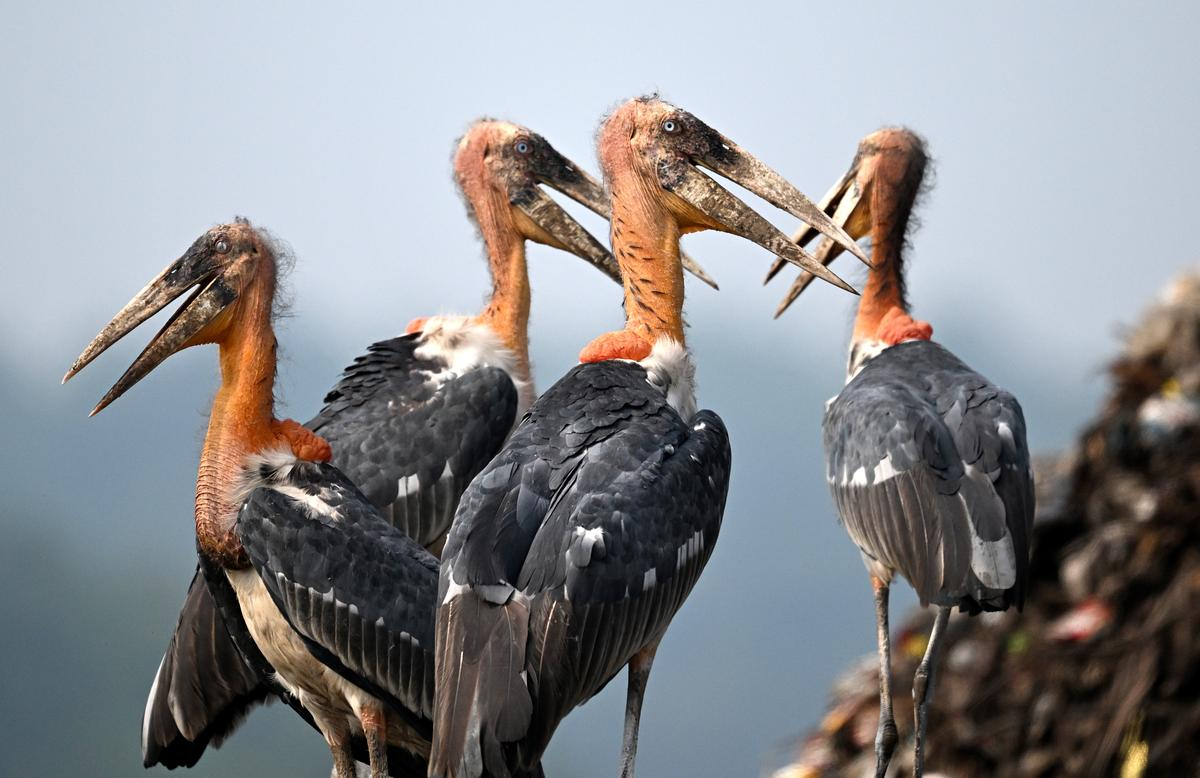Important Facts For Prelims
Greater Adjutant Stork
- 11 Jun 2024
- 5 min read
Why in News?
The Greater Adjutant Stork, locally known as ‘Garuda’ once commonly found in southern Asia and mainland southeast Asia, is now restricted to a small area Assam in India.
- This large bird is known for its distinct appearance, with a long neck, large bill, and a prominent gular pouch.
What are the Key Facts about Greater Adjutant Stork?
- Scientific Name: Leptoptilos dubius
- Genus: It is a member of the stork family, Ciconiidae. There are about 20 species in the family. They are long-necked large birds.
- Habitat: There are only 3 known breeding grounds, one in Cambodia and two in India (Assam and Bihar).
- In India, they are found with the largest colony located in Assam and a smaller one around Bhagalpur.
- In Assam, their habitat is primarily in the Brahmaputra valley, specifically in the districts of Guwahati, Morigaon, and Nagaon.
- Protection Status:
- IUCN Red List: Endangered
-
Wildlife (Protection) Act 1972: Schedule IV
- Diet:
- Principally carnivorous, feeding on fish, frogs, snakes, other reptiles, eels, birds, offal and carrion.
- It shares the habit of scavenging with vultures.
- Significance:
-
Religious Icon:
- They are considered the mount of Vishnu, one of Hinduism’s prime deities.
- Some worship the bird and call it “Garuda Maharaj” (Lord Garuda) or “Guru Garuda” (Great Teacher Garuda).
- Helpful for Farmers:
- They help farmers by killing rats and other farm pests.
-
What are the Threats and Conservation Efforts Related to Greater Adjutant Storks?
- Threats:
-
Habitat Loss: Urbanization is destroying wetlands, which are essential for these storks to forage for food. Many are now forced to rely on garbage dumps, which is not a healthy long-term solution.
- Eg: Garbage dumping site near the Deepor Beel Wildlife Sanctuary (Ramsar site).
- Encroachment and drainage projects are destroying crucial wetland ecosystems.
- For example, In Guwahati, private landowners are cutting down roosting trees (which they need for nesting), further squeezing their habitat.
- Seasonal Challenges: The breeding season (October-February) coincides with abundant fish and prey availability in wetlands.
- During the non-breeding season, these storks rely on urban waste disposal sites for food.
- Human Disturbance: Local communities often drive the birds away due to the strong odor of their droppings and the presence of rotting meat brought to feed their hatchlings.
-
-
Conservation Efforts:
-
Working with the Locals: In Assam, local communities play a significant role in the conservation of Hargila. Conservationists have engaged villagers, particularly women, in protecting nesting sites and raising awareness about the importance of these birds.
-
Protection of Nesting Sites: Efforts have been made to protect and restore nesting sites by planting trees and safeguarding existing ones where the storks nest. Community-based organizations are working to monitor and protect these sites from disturbances.
-
Awareness Campaigns: Educational programs and awareness campaigns are being conducted to change public perception and encourage coexistence with these storks.
-
UPSC Civil Services Examination Previous Year Question (PYQ)
Prelims
Q. ‘Invasive Species Specialist Group’ (that develops Global Invasive Species Database) belongs to which one of the following organizations?(2023)
(a) The International Union for Conservation of Nature
(b) The United Nations Environment Programme
(c) The United Nations World Commission for Environment and Development
(d) The World Wide Fund for Nature
Ans: (a)
Q. Other than poaching, what are the possible reasons for the decline in the population of Ganges River Dolphins? (2014)
- Construction of dams and barrages on rivers
- Increase in the population of crocodiles in rivers
- Getting trapped in fishing nets accidentally
- Use of synthetic fertilizers and other agricultural chemicals in crop-fields in the vicinity of rivers.
Select the correct answer using the code given below:
(a) 1 and 2 only
(b) 2 and 3 only
(c) 1, 3 and 4 only
(d) 1, 2, 3 and 4
Ans: (c)






-min.jpg)